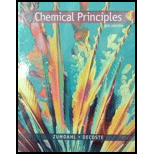
Interpretation: The mole fraction of benzene in the original solution needs to be determined.
Concept Introduction: The ratio of number of moles of a substance in a compound to the total number of moles of the compound is said to be mole fraction. The formula is:
Answer to Problem 129CP
The mole fraction of benzene in the original solution is
Explanation of Solution
Given:
Vapor pressure of pure benzene is 750.0 torr and of pure toluene is 300.0 torr.
The mole fraction in the given vapor is 0.714.
Since, the sum of all mole fractions in a given mixture is 1 so, the mole fraction of toluene in solution II is:
Where
Substituting the value of mole fraction of benzene in solution II as:
The formula for a partial pressure of a gas in mixture is:
Where
Rearranging the equation as:
The above equation is written in terms of benzene in solution II as:
According to Raoult’s Law,
Where
The value for,
Solving for
Thus, the mole fraction of benzene in solution II is 0.5 and the mole fraction of toluene in solution II is (1.0 -0.5) is 0.5.
Now, in order to calculate the mole fraction of benzene in original solution:
Let
Now, the equation (1) for solution (I) can be written as:
Rewriting the above equation using Raoult’s law as:
Since, the solution behaves ideally, so
Substituting the values:
Solving for
Hence, the mole fraction of benzene in the original solution is
Want to see more full solutions like this?
Chapter 17 Solutions
CHEM.PRINC.W/OWL2+REBATE+2 SUPPL.>IP<
- The vapor pressures of several solutions of water-propanol (CH3CH2CH2OH) were determined at various compositions, with the following data collected at 45C: H2O Vapor pressure(torr) 0 74.0 0.15 77.3 0.37 80.2 0.54 81.6 0.69 80.6 0.83 78.2 1.00 71.9 a. Are solutions of water and propanol ideal? Explain. b. Predict the sign of Hsoln for water-propanol solutions. c. Are the interactive forces between propanol and water molecules weaker than, stronger than, or equal to the interactive forces between the pure substances? Explain. d. Which of the solutions in the data would have the lowest normal boiling point?arrow_forwardThe vapor pressure of an aqueous solution of urea. CH4N2O, is 291.2 mmHg at a measured temperature. The vapor pressure of pure water at that temperature is 355.1 mmHg. Calculate the mole fraction of each component.arrow_forwardThe lattice enthalpy of sodium chloride, H for NaCl(s)Na+(g)+Cl(g) is 787 kJ/mol; the heat of solution in making up 1 M NaCl(aq) is +4.0 kJ/mol. From these data, obtain the sum of the heats of hydration of Na+ and Cl. That is obtain the sum of H values for Na+(g)Na+(aq)Cl(g)Cl(aq) If the heat of hydration of Cl is 338 kJ/mol, what is the heat of hydration of Na+?arrow_forward
 Chemistry: An Atoms First ApproachChemistryISBN:9781305079243Author:Steven S. Zumdahl, Susan A. ZumdahlPublisher:Cengage Learning
Chemistry: An Atoms First ApproachChemistryISBN:9781305079243Author:Steven S. Zumdahl, Susan A. ZumdahlPublisher:Cengage Learning
 ChemistryChemistryISBN:9781305957404Author:Steven S. Zumdahl, Susan A. Zumdahl, Donald J. DeCostePublisher:Cengage Learning
ChemistryChemistryISBN:9781305957404Author:Steven S. Zumdahl, Susan A. Zumdahl, Donald J. DeCostePublisher:Cengage Learning Chemistry: Principles and PracticeChemistryISBN:9780534420123Author:Daniel L. Reger, Scott R. Goode, David W. Ball, Edward MercerPublisher:Cengage Learning
Chemistry: Principles and PracticeChemistryISBN:9780534420123Author:Daniel L. Reger, Scott R. Goode, David W. Ball, Edward MercerPublisher:Cengage Learning General Chemistry - Standalone book (MindTap Cour...ChemistryISBN:9781305580343Author:Steven D. Gammon, Ebbing, Darrell Ebbing, Steven D., Darrell; Gammon, Darrell Ebbing; Steven D. Gammon, Darrell D.; Gammon, Ebbing; Steven D. Gammon; DarrellPublisher:Cengage Learning
General Chemistry - Standalone book (MindTap Cour...ChemistryISBN:9781305580343Author:Steven D. Gammon, Ebbing, Darrell Ebbing, Steven D., Darrell; Gammon, Darrell Ebbing; Steven D. Gammon, Darrell D.; Gammon, Ebbing; Steven D. Gammon; DarrellPublisher:Cengage Learning Principles of Modern ChemistryChemistryISBN:9781305079113Author:David W. Oxtoby, H. Pat Gillis, Laurie J. ButlerPublisher:Cengage Learning
Principles of Modern ChemistryChemistryISBN:9781305079113Author:David W. Oxtoby, H. Pat Gillis, Laurie J. ButlerPublisher:Cengage Learning





